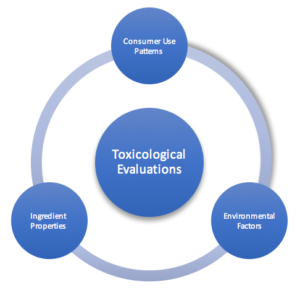The market success of personal care goods like cosmetics, skin care, and hair care products balances on manufacturers’ ability to prove both safety and efficacy of product formulations. As such, using credible and scientifically sound dermatological testing methods to prove both consumer safety and product efficacy are paramount. Moreover, the short development cycle of personal care products requires such tests to be accurately assessed in a logistically and economically efficient manner. Including qualified safety evaluators to assess the unique testing needs for each particular product type or formulation is recommended to help avoid major safety risks and development pipeline pitfalls. Initial evaluations should focus on the safety of product ingredients and their respective requirements for use, followed by clinical and market trials to confirm formulation efficacy and make improvements when and where necessary.
Key Initial Considerations for Determining Product Safety
The overall product formulation and individual ingredient toxicological profiles will determine the depths required for early safety evaluations. Formulation should supply ingredients at concentrations and in forms that maintain product efficacy while providing a safe exposure range. Product compositions featuring novel ingredients or novel processing methods require extra attention as a demonstrated safety record has yet to be established in such cases.
Toxicological profiles may be built from published and/or unpublished data that examines the following.
- Ingredient potential for acute and/or long-term genotoxic, carcinogenic, and systemic toxicity
- Likelihood of skin sensitization
- Chemical structure, chemical purity and concentration
- Likelihood of interaction with other ingredients in the end product
Such features dictate biological activity—including skin penetration capacity—and should be considered in early safety evaluations. This is of particular importance in the context of skin penetration capacity, as increased penetration is a key event in skin sensitization and systemic toxicity events. Analytical chemistry approaches, such as spectroscopy, are useful in identifying and quantifying structural variants and chemical impurities.
Environmental conditions and consumer use patterns should be considered when determining formulation safety and efficacy—namely:
- Route of exposure,
- Exposure frequency, and
- Foreseeable use/misuse patterns
- Site of exposure
 Length of exposure
Length of exposure
Products applied to the face and scalp may come into contact with the eyes and thus require consideration of formulation likelihood to cause ocular irritation. For ingredients that absorb in the UV range, UV-related photosensitization and photo-irritation should also be taken into account, as the average consumer will experience regular UV exposure outdoors. Formulations should also be such that tests for initial microbial presence are negative and microbial growth is discouraged.
Initial and pre-market safety and efficacy evaluations should be performed by experienced personnel who are qualified to define safe ingredient concentrations and determine the necessary precautions required to avoid major safety risks.
Dermatological Testing to Confirm Formulation Efficacy and Consumer Safety
Once the initial toxicological profiles are complete, premarket evaluations are necessary to confirm product safety and efficacy. In-vitro dermatological testing is recommended prior to human clinical trials to evaluate product safety. To this end, a battery of tests may be used to assess the likelihood of adverse outcomes:
1. Dermal irritation
Dermal irritation may be determined in-vitro using reconstructed human epidermis that has been engineered to recapitulate the biochemical and physiological properties of actual human skin. Following chemical or product exposure, cell viability in the reconstructed epidermis is evaluated by measuring the conversion of MTT solution into a blue formazan salt. Reduced cell viability yields a reduction in formazan salt production. Cell viability levels at 50% or lower are conventionally associated with dermal irritant status.
2. Skin sensitization
Several methods validated by the Organization for Economic Co-operation and Development (OECD) are available to determine skin sensitization likelihood. One such test is the Direct Peptide Reactivity Assay (DPRA), which detects the molecular beginnings of skin sensitization by measuring the interaction of chemical and synthetic heptapeptides. The more frequent the interaction, the more likely the chemical under evaluation is to cause skin sensitization.
3. Ocular irritation
In recent years, several in-vitro alternatives to the in-vivo Draize Eye Irritation test have been proposed. To date, no single in-vitro method has been identified as an ideal replacement for the Draize Eye Irritation test. Strategic combinations of several in-vitro methods in a tiered testing strategy, however, is regarded as an acceptable approach. An initial step in this tiered testing strategy is the Fluorescein Leakage (FL) test, which identifies severe ocular corrosives and irritants by their ability to compromise the integrity of tight junction connections between MDCK cellular membranes.
4. Phototoxicity outcomes
Phototoxic substances provoke or enhance local toxic responses when light exposure or skin irradiation follows direct application or systemic exposure, respectively. Such substances may be detected in-vitro by the 3T3 Neutral Red Uptake Phototoxicity Assay (3T3 NRU PT). Here, cells are exposed to the product under evaluation just before light exposure. Phototoxic substances will yield reduced viability of cells that are exposed to light.
Once formulation safety is established with in-vitro methods, manufacturers must confirm product performance with clinical studies. During this time, foundational skin studies may also be considered to include clinical responses from different skin types (e.g., oily, dry, mature, sensitive, etc.). Good Clinical Practices use ethically developed trials with human volunteers to confirm product efficacy and are excellent avenues to evaluate product performance and real-world safety outcomes. Clinical assessments typically evaluate acute and cumulative dermal irritation and skin sensitization outcomes in addition to product performance. Clinically substantiated product claims encourage eventual market success and longevity.
Summary
Product manufacturers are responsible for determining personal care product safety and efficacy. Safety assessment experts can help determine if appropriate and sufficient data on proposed formulations is available or if additional toxicological evaluations need to be conducted. Several ECVAM EURL validated in-vitro methods are available for determining all relevant forms of dermatological toxicity including dermal irritation, skin sensitization, ocular irritation, and phototoxicity. Clinical trials should also be performed to confirm product safety and efficacy in humans. Taken together, these approaches lead to the well-substantiated product claims that are key to ensuring market success.


